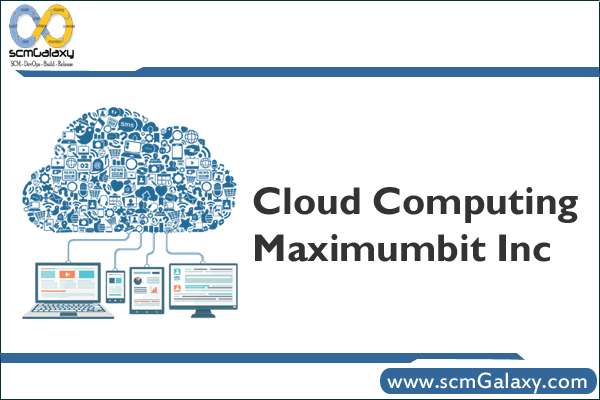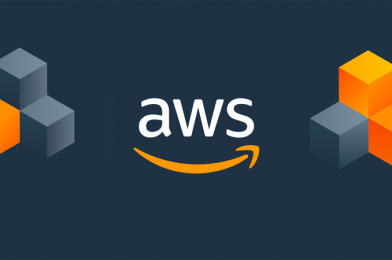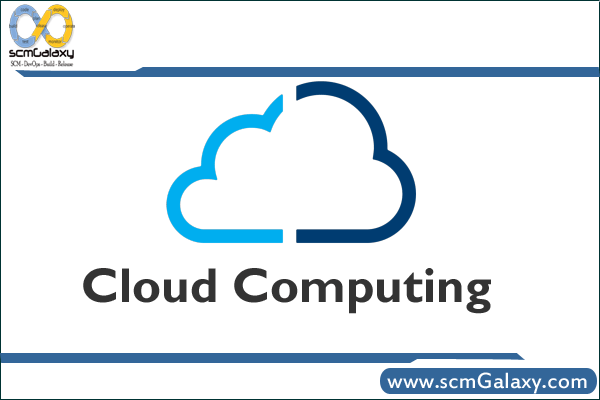
Cloud Computing is an emerging computing technology that uses the internet and central remote servers to maintain data and applications. Cloud computing allows consumers and businesses to use applications without installation and access their personal files at any computer with internet access. This technology allows for much more efficient computing by centralizing storage, memory, processing and bandwidth. Cloud computing is broken down into three segments: “applications,” “platforms,” and “infrastructure.” Each segment serves a different purpose and offers different products for businesses and individuals around the world.
Cloud computing comes into focus only when you think about what IT always needs: a way to increase capacity or add capabilities on the fly without investing in new infrastructure, training new personnel, or licensing new software. Cloud computing encompasses any subscription-based or pay-per-use service that, in real time over the Internet, extends IT’s existing capabilities.
In June 2009, a study conducted by Version One found that 41% of senior IT professionals actually don’t know what cloud computing is and two-thirds of senior finance professionals are confused by the concept, highlighting the young nature of the technology. In Sept 2009, an Aberdeen Group study found that disciplined companies achieved on average an 18% reduction in their IT budget from cloud computing and a 16% reduction in data center power costs.
Depending on who you are talking to, you will see different perceptions about what Cloud Computing actually is, from the simplest web-hosted solutions right through to virtualized processing environments with Web-Service initiated provisioning and decommissioning.
The main challenges for Cloud Computing before it is likely to enjoy wide-spread adoption are the following:
Persistence & Availability – The ability to continue working during outages or the ability to mitigate outages.
Privacy and National Security Concerns – The hosting of information outside of your country’s borders does concern Public Sector organizations. The US Patriot Act for example is a concern for some countries in adopting cloud services. It is thought that Country-silted Clouds may be able to address this.
Geo-Political Information Management Concerns – The Political risk a country takes on by housing information for another country.
Cloud Computing is all about:
1. SaaS (Software as a Service)
These type of cloud computing delivers a single application through the browser to thousands of customers using a multitenant architecture. On the customer side, it means no upfront investment in servers or software licensing; on the provider side, with just one app to maintain, costs are low compared to conventional hosting.
2. Utility computing
The idea is not new, but this form of cloud computing is getting new life from Amazon.com, Sun, IBM, and others who now offer storage and virtual servers that IT can access on demand. Early enterprise adopters mainly use utility computing for supplemental, non-mission-critical needs, but one day, they may replace parts of the datacenter. Other providers offer solutions that help IT create virtual datacenters from commodity servers, such as 3Tera’s AppLogic and Cohesive Flexible Technologies’ Elastic Server on Demand. Liquid Computing LiquidQ offers similar capabilities, enabling IT to stitch together memory, I/O, storage, and computational capacity as a virtualized resource pool available over the network.
3. Web services in the cloud
Closely related to SaaS, Web service providers offer APIs that enable developers to exploit functionality over the Internet, rather than delivering full-blown applications. They range from providers offering discrete business services to the full range of APIs and even conventional credit card processing services.
4. Platform as a service
Another SaaS variation, this form of cloud computing delivers development environments as a service. You build your own applications that run on the provider’s infrastructure and are delivered to your users via the Internet from the provider’s servers.
5. MSP (managed service providers)
One of the oldest forms of cloud computing, a managed service is basically an application exposed to IT rather than to end-users, such as a virus scanning service for e-mail or an application monitoring service (which Mercury, among others, provides). Managed security services delivered by Secure Works, IBM, and Verizon fall into this category, as do such cloud-based anti-spam services as Postini, recently acquired by Google. Other offerings include desktop management services, such as those offered by Center Beam or Ever dream.
6. Service commerce platforms
A hybrid of SaaS and MSP, this cloud computing service offers a service hub that users interact with. They’re most common in trading environments, such as expense management systems that allow users to order travel or secretarial services from a common platform that then coordinates the service delivery and pricing within the specifications set by the user. Think of it as an automated service bureau. Well-known examples include Rearden Commerce and Ariba.
7. Internet integration
The integration of cloud-based services is in its early days. OpSource, which mainly concerns itself with serving SaaS providers, recently introduced the OpSource Services Bus, which employs in-the-cloud integration technology from a little startup called Boomi. SaaS provider Workday recently acquired another player in this space, CapeClear, an ESB (enterprise service bus) provider that was edging toward b-to-b integration. Way ahead of its time, Grand Central — which wanted to be a universal “bus in the cloud” to connect SaaS providers and provide integrated solutions to customers — flamed out in 2005.
Citrix Cloud Center
C3 is designed to give cloud providers a complete set of service delivery infrastructure building blocks for hosting, managing and delivering cloud-based computing services. C3 includes a reference architecture that combines the individual capabilities of several Citrix product lines to offer a powerful, dynamic, secure and highly available service-based infrastructure ideally suited to large-scale, on-demand delivery of both IT infrastructure and application services. This architecture consists of four key components:
Platform – Powered by Citrix XenServerTM Cloud Edition: The new XenServer Cloud Edition is a powerful virtual infrastructure solution optimized for service provider environments. It combines the cloud-proven scalability of the Xen® hypervisor which powers most of the world’s largest clouds, with all the virtualization management and dynamic workload provisioning capabilities of the full Citrix XenServer product line enabling cloud providers to host and manage any combination of Windows® and Linux environments. XenServer Cloud Edition also features an innovative consumption based pricing model to meet the needs of service providers that charge their customers based on metered resource use.
Delivery – Powered by Citrix® NetScaler’s®: Through its rich policy-based AppExpert engine, Citrix NetScaler’s delivers cloud-based resources to users over the Web, continually optimizing user application performance and security by dynamically scaling the number of virtual machines (VMs) or servers available in response to changing workload demands and infrastructure availability. This allows cloud providers to balance workloads across large distributed cloud environments and transparently redirect traffic to alternate capacity on or off premise in the event of network failures or datacenter outages. NetScaler’s can also dramatically reduce server requirements in large cloud centers by offloading protocol and transaction processing from backend server pools. NetScaler’s proven architecture is designed for highly scalable, multi-tenant Web applications and delivers Web services to an estimated 75 percent of all Internet users each day.
Bridge – Powered by Citrix WANScaler: As larger enterprises begin experimenting with cloud-based services for parts of their own infrastructure and application hosting strategy, cloud providers will also need reliable and secure ways to provide a seamless bridge between hosted cloud services and premise-based enterprise services. Over time, C3 will incorporate a set of open interfaces that allow customers to easily move virtual machines and application resources into a cloud-based datacenter and back again as needed. WANScaler technology will play a critical role in this enterprise bridge by accelerating and optimizing application traffic between the cloud and the enterprise datacenter, even over long distances.
Orchestration – Powered by Citrix Workflow Studio TM: Tying it all together, Citrix Workflow Studio provides a powerful orchestration and workflow capability that allows the products in the C3 portfolio to be dynamically controlled and automated, and integrated with customer business and IT policy. Workflow Studio allows customers to control their infrastructure dynamically–integrating previously disconnected processes and products into a single powerful, orchestrated and cohesive system. This unique capability will make it easier for cloud providers to enable highly efficient burst able clouds that automatically scale resources up and down based on demand, shifting hardware resources to where they are most needed and powering them down for maximum power savings when not needed.
Today, with such cloud-based interconnection seldom in evidence, cloud computing might be more accurately described as “sky computing,” with many isolated clouds of services which IT customers must plug into individually. On the other hand, as virtualization and SOA permeate the enterprise, the idea of loosely coupled services running on an agile, scalable infrastructure should eventually make every enterprise a node in the cloud. It’s a long-running trend with a far-out horizon. But among big megatrends, cloud computing is the hardest one to argue with in the long term.
Tagged : A view of cloud computing / About Cloud Computing / Cloud / Cloud computing basics / Cloud computing beginner's guide / Cloud computing Introduction / Cloud computing overview / cloud computing services / Cloud COmputing Solution / Cloud Technology / computing / Introduction to Cloud computing / Maximumbit Inc / Sky computing / virtualization / What is cloud computing / What is cloud computing in simmple terms




